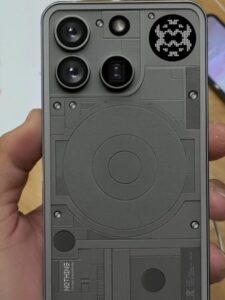As I test the Nothing Phone 3, I’ve discovered a surprising feature that I adore thus far.
Since the Nothing Phone 3’s announcement at a London event last week, I’ve been testing it. With its translucent back and Glyph Matrix rear display, I still adore the oddball design. Although it’s too early to make a firm judgment on its battery life or CPU speed, I wanted to draw attention to one noteworthy aspect that I’ve discovered. The macro mode on the camera.
Given that Nothing refers to this phone as its “first true flagship” due to its overall more prestigious spec list, it’s a unique feature to concentrate on. This phone’s specifications also indicate that it starts at $799 (£799), which puts it in line with more expensive models like the Pixel 9 and uncomfortably close to the iPhone 16.

Therefore, it definitely need an ace card to grab attention, and for me, that’s the macro mode thus far. Let me tell you why. This is a picture I got of a bee in Edinburgh on a beautiful day, enjoying a flower. With a natural drop in focus towards the background, the phone has managed to capture a stunning close-up while preserving crisp features on the insect’s head and the pollen sticking to its legs. Even the sun-drenched yellow petals preserve highlight detail, and the exposure is evenly adjusted. The colors are vivid yet still have a natural tone.
I’ve worked as a professional photographer for many years, and I also run a photography YouTube channel where I often use expensive, specialized gear to take macro photos. I could have shot this picture with any of my typical equipment, but I managed to get it with just the Nothing Phone 3’s built-in camera in macro mode; no other lens attachments or lighting were required.
However, it’s not the only phone with a macro feature. The majority of phones do, including the iPhone 16 Pro, which achieves near focus by using its ultrawide lens.
However, this is an iPhone photo of the same subject. It’s close, to be sure, and the wide-angle lens gives the flower and bee a different sense of scale, but it’s much more what I’ve grown accustomed to from phone macro settings. The crunchy, over-sharpened details and the attempt—and failure—to create background blur bother me. I used the “natural” approach in the Photographic Styles section to shoot this, but the muted yellows and desaturated greens make the colors look anything but natural.
I didn’t need to do any more work to make the Nothing Phone 3’s macro mode seem fantastic, but a ProRaw version—edited in Lightroom—looks far better. Perhaps capturing excellent pictures of insects is a niche reason to like a phone, but it’s the main feature that stands out to me as a manner that this phone stands apart from the competition.
Here are some additional findings from my preliminary tests, though.
Nothing Phone 3 Glyph Matrix
This time around, the business has replaced the lights with a tiny dot-matrix display. Nothing’s phones have always featured oddball designs with see-through screens and the light-up Glyph interface. Located on the back of the phone, the Glyph Matrix, as Nothing calls it, can show important information like the battery level or incoming messages, but it can also be utilized for more entertaining uses. There are several “Glyph Toys” available, ranging from a “spin the bottle” tool to a Magic 8 Ball feature, and developers are urged to produce more.
The Glyph Matrix is something I appreciate, and Katie Collins of CNET said it was her favorite feature of the Nothing Phone 3. Because it provides information instead of merely lighting up at random, it’s more useful than the lights on the original Nothing Phone 2. Even while playing small minigames on the tiny screen on the back of your phone is still somewhat of a gimmick, it’s refreshing to see something a little different in a world full of gray phones that are nearly identical.
The same can be said with Nothing’s phones, which are known for their translucent designs. The “inside” of the phone has been given a more blocky, cubist look this time, which makes me think of the Bauhaus art movement.
Nothing Phone 3: Snapdragon processor and triple camera array
Nothing has compromised on its flagship’s specifications. Both daily use and more intensive games should benefit from the Qualcomm Snapdragon 8S Gen 4 processor’s strong performance. My testing has shown that it is powerful enough for daily use, with PUBG functioning effectively at its highest level. I’ll save the full analysis of its performance in comparison to its competitors for when I release our entire set of benchmarks on it.
A triple-camera array with the traditional lineup of main lens, ultrawide, and telephoto zoom is located on the back of the phone. The resolution of all three cameras is 50 megapixels, matching that of the Nothing Phone 2’s normal and ultrawide cameras. However, the company claims to have made major advancements in image processing, which should lead to better-looking photographs. Although the macro feature has already amazed me, I’ve discovered that the cameras are more generally capable of taking good daily photos. I’ll save the final judgment till after I’ve conducted much more thorough testing.
An additional 50-megapixel camera, which is a significant improvement over the 32-megapixel camera on the front display, is situated there for self-taken pictures and video calls.
I’m interested to see how well these cameras work because it’s one of the main ways high-end phones, like the iPhone 16 Pro and Galaxy S25 Ultra, set themselves apart. If nothing wants to compete in the elite market, it must have excellent imaging capabilities in all kinds of situations, not just for taking close-up pictures of bees. I’m thrilled to see that several color profiles are included, and there are a ton more that can be downloaded. Being able to replicate the cinematic effects I experienced with the Nothing Phone 3A in Barcelona earlier this year was a huge help to me as a photographer. As I test more, I’m interested to see how Nothing compares.
Nothing Phone 3 other specs and features
The phone boasts a good range of specifications in addition to the cameras and the glitzy Glyph Matrix. The 5.150-mAh Silicon-carbon battery guarantees a full day of use, the 6.67-inch display has a high resolution, and the 65W rapid charging will charge it from empty to half full in just 19 minutes. Additionally, it is IP68 rated for resistance to dust and water, so making calls in the rain shouldn’t be an issue.
Additionally, it includes a number of AI features, such as Nothing’s Essential Space, which was introduced with the Phone 3A earlier this year.
In essence, the Essential Space is a place to save the voice notes and screen captures you take during the day to help you organize your mental clutter. It reminds me somewhat of a journaling tool. I’m eager to see how helpful this tool develops because nothing is integrating AI further into Essential Space and offering additional features in the upcoming months.
Although there is no indication that the phone would be updated to Android 16 later this year, it comes with Android 15 at launch. This phone should still be safe to use in 2032 because it will receive four years of software upgrades and seven years of total security updates, while there are still many things you can
Nothing Phone 3: Is it any good?
Even though I’ve only had the phone for a short while, I’m already impressed by the macro mode and the Glyph Matrix, whether or not it’s a gimmick. The processor and cameras must have top-tier performance if Nothing is serious about competing in the top leagues. To truly understand what it’s like to live with this phone, I’ll be putting it through a rigorous testing process over the next few days.
However, it might be a good choice at a price that’s more affordable than the majority of its flagship competitors if it performs as well as Nothing claims.









